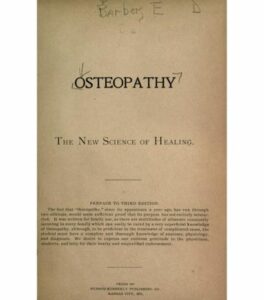Osteopathy. The New Science of Healing by Elmer DeVergne Barber
The first volume ever written on osteopathy, with the declared intent of divulging the possibility to cure many disorders to everybody, even to those with a superficial knowledge of the new discipline.
 Publisher: Hudson-Kimberly Publishing Co, Kansas City, MO (USA)
Publisher: Hudson-Kimberly Publishing Co, Kansas City, MO (USA)
Year of publication: 1896
Number of pages: 170
Dr Barber, who graduated in March 1895 at the ASO of Kirksville, had opened the National School of Osteopathy in which he taught an approach to osteopathy radically different from the one supported by A.T.Still.
This volume is based on Barber’s notes, taken in the two years of course at the ASO. Despite recognising the merit of having discovered osteopathy to Still, at pages 11 and 12 Barber specifies that the master was wrong, as the disorders are not caused by the “dislocated bones” but by the “contracted muscles”.
Because his intent was to reach a wide public, Barber chose a simple and understandable language, avoiding medical and anatomical vocabulary and attributing to himself the merit of disclosing the new science to the world, in all its greatness, simplicity and truth. He maintained that anyone, even without any type of training, could have used his book, which he had enriched with numerous explanatory illustrations especially for this purpose, to cure themselves, their family and other people.
The volume opens with the analytical index and a glossary. The index is a list of pathologies, for any of which, he describes the symptoms and the most appropriate treatment. At the beginning of the volume some paragraphs are dedicated to a simple explanation of osteopathy and the techniques used to apply it.
In the last three pages of the book the benefits of osteopathy to shorten time of labor and soothe pain during childbirth are described, followed by a listing of the bones composing the human skeleton.
The orthodox physicians sued this book and the following more substantial one published by the same author in 1898, Osteopathy Complete, as a proof that osteopathy was a charlatan’s practice.1
Strengths: brief book of great historical interest, featuring an initial index which facilitates its consultation.
Weaknesses: certainly founded on the original teachings of A.T. Still, but as interpreted by Barber in a simplistic manner and in a perspective different from the one of its founder.
- Gevitz, N. “The ‘Doctor of Osteopathy’: Expanding the Scope of Practice”. JAOA, March 2014, v. 114, n. 3: 201ss

Are you an osteopath?
Register and enjoy the membership benefits. Create your public profile and publish your studies. It's free!
Register now
School or training institution?
Register and enjoy the membership benefits. Create your public profile and publish your studies. It's free!
Register now
Do you want to become an osteopath? Are you a student?
Register and enjoy the membership benefits. Create your public profile and publish your studies. It's free!
Register nowHistorical osteopathy books
Osteopathy Research and Practice by Andrew Taylor Still
The fourth book of A.T. Still, written at the age of 82 years, enunciates the principles and the practical maneuvers of osteopathy in reference to the single pathologies, classified by body regions.
ReadHistory of Osteopathy and Twentieth-Century Medical Practice by Emmons Rutledge Booth
A milestone in the history of osteopathy. Emmons Rutledge Booth, who enrolled at the ASO in Kirksville in 1898 and graduated in 1900, met A.T. Still personally.
ReadPhilosophy of Osteopathy by Andrew Taylor Still
The second book published by A.T. Still, it collects the basic principles of osteopathy, written over several years and then gathered in one volume. Despite the insistence of his friends, Still was not sure that the time was ripe to divulge his early science.
ReadAutobiography of Andrew Taylor Still with a History of the Discovery and Development of the Science of Osteopathy by A. T. Still
A fundamental text to begin to know the founder of osteopathy and to understand the cultural context and the historical events during which his life unfolded.
ReadPrimitive Physick: or, an Easy and Natural Method of Curing most Diseases by John Wesley
A fundamental text for the Methodists, which Still’s father surely knew and probably owned - in addition to remedies, the book contains a preface that dispenses advice for a healthy life.
ReadThe Old Doctor by Leon Elwin Page
A small volume dedicated to the story of Andrew Taylor Still, and to the birth and development of the idea of osteopathy.
ReadThe Cure of Disease by Osteopathy, Hydropathy and Hygiene A Book for the People by Ferdinand L. Matthay
A small volume addressed to the general public, dispensing health advice and illustrating some osteopathic techniques.
ReadOsteopathy; the New Science by William Livingston Harlan
The volume collects and comments a series of relevant articles on the new science of osteopathy, highlighting legal, historical and theoretical aspects.
ReadA Manual of Osteopathy – with the Application of Physical Culture, Baths and Diet by Eduard W Goetz
Very schematic volume, with the aim of spreading the osteopathic application techniques to everybody, even to those lacking any sort of health training.
Read







